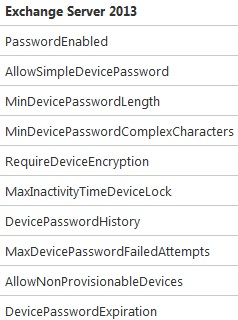Your network contains a Microsoft Exchange Server 2013 organization.
You have an Exchange ActiveSync policy that has the following settings configured:
-> AllowRemoteDesktop
-> AllowIntemetSharing
-> RequireDeviceEncryption
-> MinDevicePasswordLength
-> AllowSimpleDevicePassword
You need to identify which settings are applied to Windows RT 8.1 devices.
Which three settings should you identify? (Each correct answer presents part of the solution. Choose three.)
- A. AllowRemoteDesktop
- B. AllowSimpleDevicePassword
- C. RequireDeviceEncryption
- D. MinDevicePasswordLength
- E. AllowInternetSharing
Answer : B,C,D
Explanation: Windows 8\RT Supported Policy Parameters for EAS mailbox policies:

C:\Users\Chaudhry\Desktop\1.jpg -
Reference: Supported Exchange ActiveSync policy parameters in Windows 8 and RT
Your network contains an Active Directory domain. All client computers run Windows 8.1
Enterprise.
Microsoft System Center 2012 Endpoint Protection is deployed to all of the computers by using the default settings contained in the Default Antimalware Policy.
The users in the research department report that a folder named C:\TestApp must not be scanned by the Endpoint Protection client.
You need to configure the Endpoint Protection client not to scan the C:\TestApp folder for the computers in the research department only.
What should you do first?
- A. In the Endpoint Protection client, modify the Excluded files and locations setting for each research department computer.
- B. Create a new antimalware policy and modify the Threat overrides settings.
- C. Create a new antimalware policy and modify the Exclusion settings.
- D. In the Default Antimalware Policy, modify the Exclusion settings.
Answer : C
Explanation:
http://technet.microsoft.com/en-us/library/hh508785.aspx
An organization has client computers that run Windows 7. You upgrade the client computers to Windows 8 without migrating the local user profiles.
You install the Windows Assessment and Deployment Kit (ADK) in the environment.
You need to migrate the user profiles from the Windows 7 installation to the Windows 8 installation.
What should you do first on each client computer?
- A. Copy the Default Profile to a folder on drive C.
- B. Run Windows Easy Transfer and select the user profile to migrate.
- C. Run the scanstate command.
- D. Run the loadstate command.
- E. Run the ImageX command.
Answer : C
You support desktop computers and tablets that run Windows 8 Enterprise. All of the computers are able to connect to your company network from the Internet by using
DirectAccess.
Your company wants to deploy a new application to the tablets. The deployment solution must meet the following requirements:
-> The application is stored locally on the tablets.
-> Access to the application is protected with extra logon credentials, in addition to a standard domain account used by users.
-> The application utilizes the least amount of network bandwidth.
-> The application must maintain access to the current desktop.
You need to deploy the new application to the tablets.
What should you do?
- A. Deploy the application as an Application Virtualization (App-V) package. Install the App- V 4.6 client on the tablets.
- B. Deploy the application as a published application on the Remote Desktop server. Create a Remote Desktop connection on the tablets.
- C. Install the application on a local drive on the tablets.
- D. Install the application in a Windows To Go workspace.
- E. Install Hyper-V on tablets. Install the application on a virtual machine.
- F. Publish the application to Windows Store.
- G. Install the application within a separate Windows 8 installation in a virtual hard disk (VHD) file. Configure the tablets with dual boot.
- H. Install the application within a separate Windows 8 installation in a VHDX file. Configure tablets with dual boot.
Answer : E
Explanation:
http://technet.microsoft.com/en-us/library/hh857623.aspx
You administer Windows 8.1 Enterprise computers in your company network. You provide remote employees with a Windows To Go workspace.
A remote employee informs you that his workspace requires activation.
You need to activate the workspace.
What should you do?
- A. Instruct the employee to run Windows Update from the workspace.
- B. Instruct the employee to connect to the company network from the workspace by using VPN.
- C. Instruct the employee to run the slmgr /upk command from the workspace.
- D. Give the employee a Multiple Activation Key (MAK).
Answer : B

